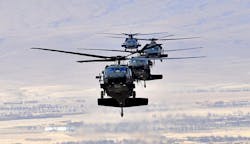Here’s how Army aviation is tackling the open architecture challenge
WASHINGTON - The Army aviation branch, which has long been seeking a modular open systems architecture for future aircraft, is refocusing its attention on past failures and new processes to ensure these next-generation aircraft are able to seamlessly receive new capability, Jen Judson reports for DefenseNews. Continue reading original article.
The Intelligent Aerospace take:
October 14, 2021 - A Center for Strategic and Budgetary Assessments report says that in utilizing an open ecosystem like MOSA would "help avoid costly and time-consuming redesign to accommodate both hardware and software upgrades by making standards and interfaces readily available."
MOSA is not “a complex thing to understand,” Brig. Gen. Robert Barrie, the service’s program executive officer for aviation, said in an interview with Defense News ahead of the Association of the U.S. Army’s annual conference.
“The thought is that we want to invest in capability once and then we want to be able to apply that capability very affordably across multiple platforms,” he continued. “To date, we have been immensely challenged in our ability to do that.”
Related: LYNX MOSA.ic for Avionics now supports 11th generation Intel Core processors
Jamie Whitney, Associate Editor
Intelligent Aerospace
